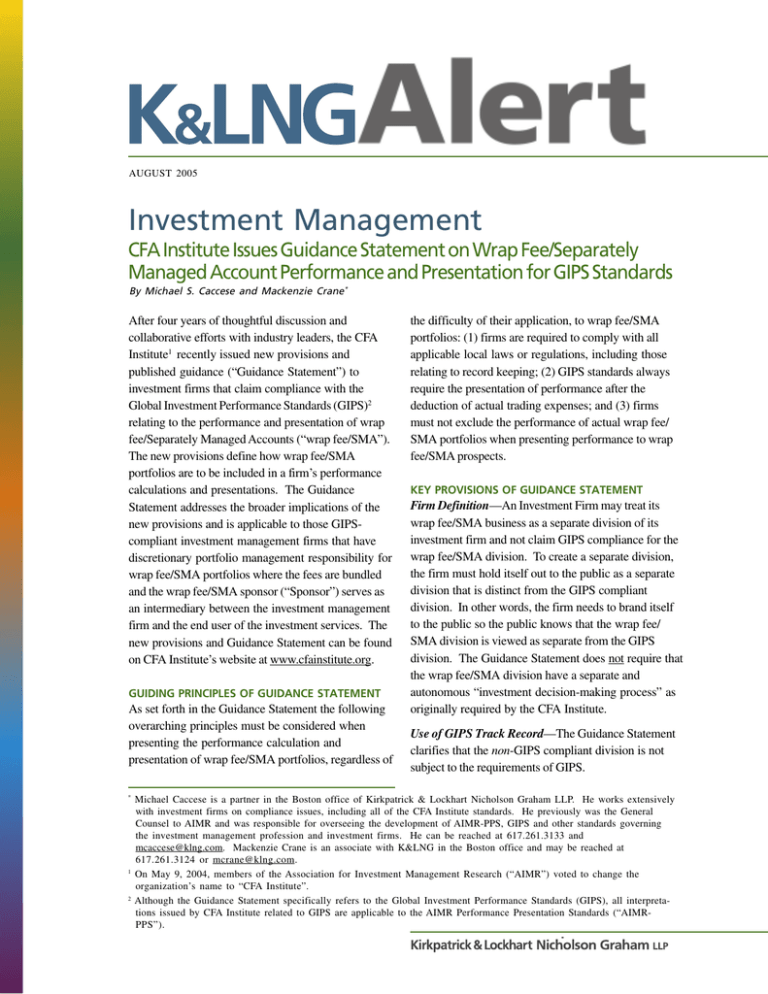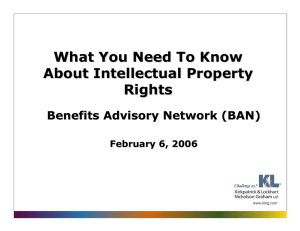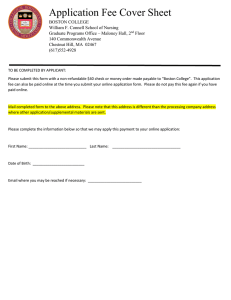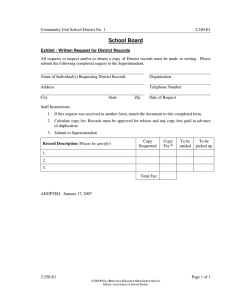
AUGUST 2005
Investment Management
CFA Institute Issues Guidance Statement on Wrap Fee/Separately
Managed Account Performance and Presentation for GIPS Standards
By Michael S. Caccese and Mackenzie Crane *
After four years of thoughtful discussion and
collaborative efforts with industry leaders, the CFA
Institute1 recently issued new provisions and
published guidance (“Guidance Statement”) to
investment firms that claim compliance with the
Global Investment Performance Standards (GIPS)2
relating to the performance and presentation of wrap
fee/Separately Managed Accounts (“wrap fee/SMA”).
The new provisions define how wrap fee/SMA
portfolios are to be included in a firm’s performance
calculations and presentations. The Guidance
Statement addresses the broader implications of the
new provisions and is applicable to those GIPScompliant investment management firms that have
discretionary portfolio management responsibility for
wrap fee/SMA portfolios where the fees are bundled
and the wrap fee/SMA sponsor (“Sponsor”) serves as
an intermediary between the investment management
firm and the end user of the investment services. The
new provisions and Guidance Statement can be found
on CFA Institute’s website at www.cfainstitute.org.
GUIDING PRINCIPLES OF GUIDANCE STATEMENT
As set forth in the Guidance Statement the following
overarching principles must be considered when
presenting the performance calculation and
presentation of wrap fee/SMA portfolios, regardless of
*
1
2
the difficulty of their application, to wrap fee/SMA
portfolios: (1) firms are required to comply with all
applicable local laws or regulations, including those
relating to record keeping; (2) GIPS standards always
require the presentation of performance after the
deduction of actual trading expenses; and (3) firms
must not exclude the performance of actual wrap fee/
SMA portfolios when presenting performance to wrap
fee/SMA prospects.
KEY PROVISIONS OF GUIDANCE STATEMENT
Firm Definition—An Investment Firm may treat its
wrap fee/SMA business as a separate division of its
investment firm and not claim GIPS compliance for the
wrap fee/SMA division. To create a separate division,
the firm must hold itself out to the public as a separate
division that is distinct from the GIPS compliant
division. In other words, the firm needs to brand itself
to the public so the public knows that the wrap fee/
SMA division is viewed as separate from the GIPS
division. The Guidance Statement does not require that
the wrap fee/SMA division have a separate and
autonomous “investment decision-making process” as
originally required by the CFA Institute.
Use of GIPS Track Record—The Guidance Statement
clarifies that the non-GIPS compliant division is not
subject to the requirements of GIPS.
Michael Caccese is a partner in the Boston office of Kirkpatrick & Lockhart Nicholson Graham LLP. He works extensively
with investment firms on compliance issues, including all of the CFA Institute standards. He previously was the General
Counsel to AIMR and was responsible for overseeing the development of AIMR-PPS, GIPS and other standards governing
the investment management profession and investment firms. He can be reached at 617.261.3133 and
mcaccese@klng.com. Mackenzie Crane is an associate with K&LNG in the Boston office and may be reached at
617.261.3124 or mcrane@klng.com.
On May 9, 2004, members of the Association for Investment Management Research (“AIMR”) voted to change the
organization’s name to “CFA Institute”.
Although the Guidance Statement specifically refers to the Global Investment Performance Standards (GIPS), all interpretations issued by CFA Institute related to GIPS are applicable to the AIMR Performance Presentation Standards (“AIMRPPS”).
Wrap Fee/SMA Account—A firm has a choice of
what it considers a wrap fee/SMA account for GIPS
purposes. An account can either be each investor that
participates in a wrap fee/SMA sponsor’s program, or
each sponsor’s program.
Records—A firm does not need records that support
the wrap fee/SMA program performance prior to
January 1, 2006. Commencing 2006, the firm needs
to implement shadow accounting, rely on the wrap
fee/SMA sponsor’s records, or treat each sponsor
program as an account and perform nominal due
diligence to reasonably determine that the
performance reported by the wrap fee/SMA sponsor is
accurate. The authors believe that, unless a firm is
currently “shadowing” accounts for record keeping
purposes, the firm will opt for the record keeping grace
period through the end of 2005 (i.e., no supporting
records are required prior to January 1, 2006) and then
treat each sponsor program as one account as
permitted under the Guidance Statement, relying on
the performance prepared by the sponsor. A firm still
needs to address any SEC record keeping
requirements.
Sponsor Specific Composite Gross-of-Fees—A firm
may create a sponsor specific composite that does not
include performance net of the entire wrap fee/SMA
fee, so long as the presentation discloses that the
named sponsor specific presentation is only for the use
of the named wrap fee/SMA sponsor or for non-wrap
fee/SMA clients and prospects.
Sponsor Specific Composite Net-of-Fees—A firm may
create a net-of-fees sponsor specific composite that the
sponsor is permitted to deliver to prospective wrap
fee/SMA program clients.
Style Specific Composite Gross-of-Fees (Existing
Sponsor)—A firm may deliver a style specific
composite gross-of-fees (but after identifiable trading
costs) to a wrap fee/SMA program sponsor that the
firm has already entered into a wrap fee/SMA program
agreement.
Style Specific Composite Net-of-Fees (Prospective
Sponsor)—A firm may deliver a style specific
composite net of the entire wrap fee/SMA fee the first
time performance is shown to a prospective sponsor to
obtain new business.
3
Wrap Fee/SMA Sponsor Use of Firm Performance—
A firm is not obligated to monitor the sponsor’s use of
the firm’s performance once provided by the firm to
the sponsor.
Effective Date—Prior to the effective date of January
1, 2006, a firm may link non-compliant performance
to its ongoing performance record. For example, a
firm may use representative wrap fee/SMA
performance to establish the mandatory five plus years
of performance history. However, a firm must currently
claim compliance with GIPS, and not AIMR-PPS, if it
wishes to comply with the Guidance Statement prior
to the January 1, 2006 effective date.
DEFINITION OF FIRM
Under GIPS an investment firm, subsidiary or division
may be defined as a firm if it is held out to the public
as a distinct business entity that is: (1)
organizationally and functionally segregated from
other divisions; (2) retains discretion over the assets it
manages; and (3) generally has autonomy over the
investment decision-making process. Organizations
that have both a non-wrap fee/SMA division and a
wrap fee/SMA division have several alternatives for
defining the firm under the GIPS standards.
Define the Entire Organization as the Firm and
the Firms Claim Compliance with the GIPS
Standards
Where both the wrap fee/SMA and non-wrap fee/SMA
divisions are held out to the public as one entity, the
entire organization should be defined as the firm for
purposes of GIPS compliance. Several benefits are
likely to inure to the benefit of an organization that
chooses this definition. First, both divisions’
portfolios are included in the calculation of the firm’s
total assets under management. Second, the firm has
the option to combine the wrap fee/SMA and nonwrap fee/SMA portfolios with similar investment
objectives and/or strategies in the same composite
(subject to certain additional required calculations
and disclosures). Finally, to calculate a wrap fee/SMA
performance history before a firm actually acquires
actual wrap fee/SMA portfolios, a firm may use the
historical non-wrap fee/SMA gross-of-fees3
performance history, adjusted to deduct the highest
total wrap fee charged. A firm must also be aware,
Gross-of-Fees Returns are returns that must be reduced by the entire bundled fee charged by the wrap fee/SMA sponsor or the
portion of the bundled fee that includes the direct trading expenses, if determinable. A firm is required to disclose if fees,
apart from trading expenses, are deducted.
2 AUGUST 2005
KIRKPATRICK & LOCKHART NICHOLSON GRAHAM LLP
however, that if it presents wrap fee/SMA portfolios in
a composite to non-wrap fee/SMA prospective or
current sponsors, the firm must deduct the entire wrap
fee from the performance from those portfolios. It
must do so, unless it is able to identify and deduct
either the actual trading expenses charged to wrap fee/
SMA portfolios or the portion of the wrap fee
attributable to trading expenses charged.
Define the Divisions Separately
Even if divisions of an organization are not
organizationally and functionally separate or
independent of each other, they may still be
considered separate firms, for compliance purposes if
their operations and functions are distinct within the
organization and the divisions are held out to the
public as distinct entities. In this circumstance, a
claim of compliance with the GIPS standards may be
made solely by either division or, alternatively, by
both divisions independently. If defined as two firms,
both of which claim GIPS compliance, each division
is subject to the limitation that one division may not
show assets or performance of the other, except as
supplemental information to a compliant presentation.
The Guidance Statement also clarifies that a non-GIPS
compliant wrap fee/SMA division is not subject to
any of the GIPS requirements.
CONSTRUCTING AND MAINTAINING COMPOSITES
FOR WRAP FEE/SMA PORTFOLIOS
Establishing a Track Record
The Guidance Statement further details how a firm
with no pre-existing track record in managing wrap
fee/SMA portfolios may simulate a strategy-specific
historical performance composite before it actually
begins to manage wrap fee/SMA portfolios. To do so,
a firm must identify the highest wrap fee4 to be
charged by the Prospective Sponsor5 and deduct it
from the firm’s historical, non-wrap fee/SMA gross-offees performance history for that particular investment
strategy composite. This calculation will result in a
4
5
6
composite demonstrating returns of wrap fee/SMA
portfolio performance that are net-of-fees.6
Maintaining Composites Once Wrap Fee/SMA
Portfolios are Managed
Once a firm begins managing actual wrap fee/SMA
portfolios this performance must be included in the
appropriate composite in accordance with the firm’s
established portfolio inclusion policies. In
accordance with its policies, a firm must decide if it
will combine wrap fee/SMA portfolios in a composite
with similar strategy non-wrap fee/SMA portfolios, or
if it will have separate composites for the non-wrap
fee/SMA portfolios. Once a firm includes non-wrap/
SMA portfolios in its wrap fee/SMA composite
history, the firm is prohibited from striping those
portfolios out at a later date to create a separate wrap
fee/SMA composite history. The GIPS standards also
require that for all wrap fee/SMA composite
presentations that include periods prior to the
composite containing an actual wrap fee/SMA
portfolio, the firm must disclose, for each period
presented, that the composite does not contain actual
wrap fee/SMA portfolios.
PERFORMANCE PRESENTATION AND
CALCULATIONS
Wrap Fee/SMA Presentations to Prospective
Sponsors
When presenting performance to a Prospective
Sponsor the composite presented must be “style
defined” and must be calculated and presented net-offees. A “style defined” composite groups all
appropriate wrap fee/SMA portfolios with the same
investment style or strategy in one composite,
regardless of the underlying Sponsor. Alternatively,
the firm may combine the on going performance of
non-wrap fee/SMA portfolios with wrap fee portfolios
managed with the specified strategy, regardless of the
underlying Sponsor.
CFA Institute acknowledges that by reducing the non-wrap fee/SMA composite history by the highest wrap fee to be charged
by the prospective sponsor, the simulated performance will actually reflect the deduction of trading expense two times
(actual and portion of highest wrap fee). If the firm can identify the portion of the highest total wrap fee attributable to
trading expenses, once the above stated calculation is complete, the firm may then increase the “original” net-of-fees
performance calculation by this identifiable portion in order to compute a true net-of-fees return.
A Prospective Sponsor is a wrap fee/SMA sponsor for which a firm is not currently managing any wrap fee/SMA portfolios,
but is seeking to engage as a sponsor of a wrap fee/SMA program.
Net-of-fee returns are returns that must be reduced by the entire bundled fee or the portion of the bundled fee that includes
the direct trading expenses and investment management fee, if determinable. A firm is required to disclose if fees, other than
trading expenses and advisory fees, are deducted.
3 AUGUST 2005
KIRKPATRICK & LOCKHART NICHOLSON GRAHAM LLP
Irrespective of whether or not the composite presented
includes non-wrap fee/SMA portfolios as well as wrap
fee/SMA portfolios, performance returns provided to
Prospective Sponsors must be calculated and
presented net of the entire bundled fee. This is true
even if the firm is capable of determining what portion
of the wrap fee is attributable to trading expenses.
Gross-of-fees performance may be presented as
supplemental material to the Prospective Sponsor.
Wrap Fee/SMA Presentations to Existing Clients
CFA Institute also recognized in the Guidance
Statement that firms reporting the performance of wrap
fee/SMA portfolios to an Existing Sponsor need to
report how the firm has performed managing a
particular “product” for that Sponsor. As such, CFA
Institute accepted the notion of creating a “sponsor
specific” composite, including additional disclosures,
that may be used for purpose of generating additional
business with an Existing Sponsor7 . Furthermore,
when reporting performance to an Existing Sponsor,
the firm may choose whether to show returns on a
gross (but after identifiable transaction costs) or netof-fees basis. These sponsor specific presentations
must bear the name of the Sponsor, and if the returns
are calculated gross-of-fees, the firm must include
prominent disclosure that the composite presentation
is only for the use of the named Sponsor or for nonwrap fee/SMA clients or prospects of the Sponsor.
Use of Supplemental Information
Regardless of whether the recipient of the presentation
is a Prospective or Existing Sponsor, a firm may
always choose to present “pure” gross-of-fees8
performance returns as supplemental information to a
compliant presentation.
Use of Aggregate Information
In calculating performance, CFA Institute granted
firms the ability to rely on performance reported by
the Sponsor on either the aggregate level (reflecting
the Sponsor as a single portfolio) or on the underlying
portfolios of each Sponsor (reflecting each individual
end user as a wrap fee/SMA portfolio). Thus, making
7
8
it easier for the firm to rely on performance that is
generated by the underlying Sponsor.
RECORDS
Sponsors typically maintain underlying portfolio
records and the firm may not have access to those
records. Firms, however, are responsible for reporting
performance in accordance with the GIPS standards
regardless of the difficulty in accessing the data
necessary to substantiate portfolio level performance
from these Sponsors. To satisfy the requirement of the
GIPS standards, a firm may rely on the performance
calculated and reported by the Sponsor or,
alternatively, may track the wrap fee/SMA portfolios
in-house, so long as the records for each account
enable the firm to determine the beginning and end of
reporting period values and cash flows (“shadowing”).
If the firm chooses to rely on performance calculated
and reported by the Sponsor, it remains the firm’s
responsibility to ensure with reasonable diligence that
the Sponsor’s information can be used by the firm,
pursuant to the GIPS standards.
A firm need not, however, monitor and keep records
relating to the Sponsor’s use of the firm’s performance
presentations once a presentation has been provided
by the firm to the Sponsor.
Commencing January 1, 2006, a firm must maintain or
have access to supporting records for all wrap fee/
SMA portfolios included in a composite (i.e.,
shadowing; access to the Sponsor’s records when the
firm treats each Sponsor client as a portfolio; or the
performance record delivered by the Sponsor when the
firm treats the Sponsor as a portfolio). A firm will not
need records for GIPS compliance to support wrap fee/
SMA portfolios included prior to that date. A firm will
need to consider any applicable SEC or other
regulatory record keeping requirements to support its
performance presentations.
EFFECTIVE DATE
The effective date of the new provisions and Guidance
Statement is January 1, 2006. For periods prior to the
effective date of January 1, 2006, a firm claiming
An Existing Sponsor is a wrap fee/SMA sponsor for which the firm is presently managing wrap fee/SMA portfolios for in
accordance to a specific investment strategy.
“Pure” gross-of-fee returns are returns that must be reduced by the entire amount of all expenses, including trading expenses.
4 AUGUST 2005
KIRKPATRICK & LOCKHART NICHOLSON GRAHAM LLP
compliance with GIPS may link non-compliant
performance to its ongoing performance record,
provided that the firm discloses the periods of
noncompliance and explains how the presentation is
not in compliance with the GIPS standards. No
retroactive compliance is recommended or
mandated.
Michael S. Caccese
mcaccese@klng.com
617.261.3133
Mackenzie Crane
mcrane@klng.com
617.261.3124
If you have questions or would like more information about K&LNG’s Investment Management Practice,
please contact one of our lawyers listed below:
BOSTON
Michael S. Caccese
Mark P. Goshko
Thomas Hickey III
Nicholas S. Hodge
George Zornada
617.261.3133
617.261.3163
617.261.3208
617.261.3210
617.261.3231
mcaccese@klng.com
mgoshko@klng.com
thickey@klng.com
nhodge@klng.com
gzornada@klng.com
LONDON
Philip J. Morgan
44.20.7360.8123
pmorgan@klng.com
LOS ANGELES
William P. Wade
310.552.5071
wwade@klng.com
NEW YORK
Robert J. Borzone, Jr.
Jeffrey M. Cole
Ricardo Hollingsworth
Beth R. Kramer
Richard D. Marshall
Keith W. Miller
Scott D. Newman
212.536.4029
212.536.4823
212.536.4859
212.536.4024
212.536.3941
212.536.4045
212.536.4054
rborzone@klng.com
jcole@klng.com
rhollingsworth@klng.com
bkramer@klng.com
rmarshall@klng.com
kmiller@klng.com
snewman@klng.com
SAN FRANCISCO
Jonathan D. Joseph
David Mishel
Timothy B. Parker
Mark D. Perlow
Richard M. Phillips
415.249.1012
415.249.1015
415.249.1042
415.249.1070
415.249.1010
jjoseph@klng.com
dmishel@klng.com
tparker@klng.com
mperlow@klng.com
rphillips@klng.com
WASHINGTON
Clifford J. Alexander
Diane E. Ambler
Mark C. Amorosi
Catherine S. Bardsley
Arthur J. Brown
Arthur C. Delibert
Jennifer R. Gonzalez
Robert C. Hacker
Kathy Kresch Ingber
Michael J. King
Rebecca H. Laird
Deborah A. Linn
Cary J. Meer
R. Charles Miller
Dean E. Miller
Charles R. Mills
Jean E. Minarick
R. Darrell Mounts
C. Dirk Peterson
David Pickle
Alan C. Porter
Theodore L. Press
Francine J. Rosenberger
Robert H. Rosenblum
William A. Schmidt
Lori L. Schneider
Lynn A. Schweinfurth
Donald W. Smith
Martin D. Teckler
Robert A. Wittie
Robert J. Zutz
202.778.9068
202.778.9886
202.778.9351
202.778.9289
202.778.9046
202.778.9042
202.778.9286
202.778.9016
202.778.9015
202.778.9214
202.778.9038
202.778.9874
202.778.9107
202.778.9372
202.778.9371
202.778.9096
202.778.9029
202.778.9298
202.778.9324
202.778.9887
202.778.9186
202.778.9025
202.778.9187
202.778.9464
202.778.9373
202.778.9305
202.778.9876
202.778.9079
202.778.9890
202.778.9066
202.778.9059
calexander@klng.com
dambler@klng.com
mamorosi@klng.com
cbardsley@klng.com
abrown@klng.com
adelibert@klng.com
jgonzalez@klng.com
rhacker@klng.com
kingber@klng.com
mking@klng.com
rlaird@klng.com
dlinn@klng.com
cmeer@klng.com
cmiller@klng.com
dmiller@klng.com
cmills@klng.com
jminarick@klng.com
dmounts@klng.com
dpeterson@klng.com
dpickle@klng.com
aporter@klng.com
tpress@klng.com
francine.rosenberger@klng.com
rrosenblum@klng.com
william.schmidt@klng.com
lschneider@klng.com
lschweinfurth@klng.com
dsmith@klng.com
mteckler@klng.com
rwittie@klng.com
rzutz@klng.com
www
w.. k l n g . c o m
BOSTON DALLAS HARRISBURG LONDON LOS ANGELES MIAMI NEWARK NEW YORK PALO ALTO PITTSBURGH SAN FRANCISCO WASHINGTON
■
■
■
■
■
■
■
■
■
■
■
Kirkpatrick & Lockhart Nicholson Graham LLP (K&LNG) has approximately 1,000 lawyers and represents entrepreneurs, growth and middle market
companies, capital markets participants, and leading FORTUNE 100 and FTSE 100 global corporations nationally and internationally.
K&LNG is a combination of two limited liability partnerships, each named Kirkpatrick & Lockhart Nicholson Graham LLP, one qualified in Delaware, U.S.A.
and practicing from offices in Boston, Dallas, Harrisburg, Los Angeles, Miami, Newark, New York, Palo Alto, Pittsburgh, San Francisco and Washington and
one incorporated in England practicing from the London office.
This publication/newsletter is for informational purposes and does not contain or convey legal advice. The information herein should not be used or relied
upon in regard to any particular facts or circumstances without first consulting a lawyer.
Data Protection Act 1988 - We may contact you from time to time with information on Kirkpatrick & Lockhart Nicholson Graham LLP seminars and with our
regular newsletters, which may be of interest to you. We will not provide your details to any third parties. Please e-mail cgregory@klng.com if you would
prefer not to receive this information.
© 2005 KIRKPATRICK & LOCKHART NICHOLSON GRAHAM LLP. ALL RIGHTS RESERVED.




